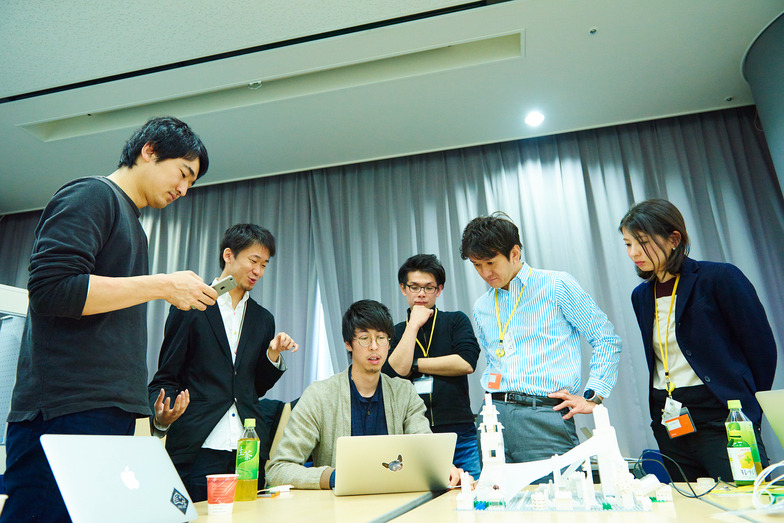"Tokyo in 2030" conceived with MIT Media Lab students: The future envisioned at TOKYO MIRAI IDEATHON
What will Tokyo look like 15 years from now? With the 2020 Tokyo Olympics approaching, momentum is building not only within government but across various industries to develop "the future of the city." To explore the infinite possibilities unfolding in the city, Dentsu Inc., Digital Garage, and ISID InnoLab hosted an ideathon inviting students from the Massachusetts Institute of Technology (MIT) Media Lab.
TEXT BY ARINA TSUKADA
PHOTOGRAPHS BY TAKESHI SHINTO

One remarked, "Storytelling power is essential for envisioning future cities," while another noted, "I was surprised by how many historical buildings Tokyo actually has."
"Inventing Tokyo in 2030." The theme of the "TOKYO MIRAI IDEATHON," held on February 23 and 24, revealed valuable perspectives akin to an "outsider's view" through the words of five MIT Media Lab students who participated in a "business trip format."
Thinking about Tokyo's future means re-examining Japan as a nation by considering new industries, services, infrastructure, and culture, and contemplating every element related to people's lives and society.
For instance, as sensing technology advances, current communication methods—relying on text and voice—may evolve, potentially replaced by the transmission of tactile sensations or emotions themselves. Artists and engineers bringing fresh insights to the design of public spaces like roads and parks could foster entirely new values.
While possibilities are limitless, many domestic companies struggle with innovation deficits. Moving forward, the key to vividly envisioning the "future" and evolving it into something achievable will lie in cross-disciplinary connections and the perspectives and skills of people with diverse backgrounds.
It is precisely against this backdrop that students from MIT Media Lab were invited to Tokyo, as mentioned at the outset, to incorporate cutting-edge technological insights and fresh perspectives from abroad.
Seven teams participated. Elite teams were assembled from both inside and outside the company, including Dentsu Inc. CDC Creative Director Yasuharu Sasaki, Dentsu Inc. Blue President and CEO Kazutaka Yoshiwa, and even researchers in human-computer interaction like Junichi Koyomimoto, who served as facilitator. Indeed, over those two days, remarkably free-flowing ideas were exchanged with the MIT Media Lab students.

Day one began with group work at Toranomon Hills. MIT Media Lab students were assigned to 56 groups across the seven teams, conducting approximately one and a half days of group work. Teams selected topics from ten pre-presented themes—such as "Future Hospitality," "Future Cityscapes," "Future Communication," and "Future Play"—and advanced discussions in preparation for the final day's presentations.

The conference room at Dentsu Inc. Headquarters served as the venue for Day 2.
The Day 2 presentations featured a panel of judges: Fumihiko Ishimaru, Executive Officer at Digital Garage; Masahiko Ogasawara, Director at Mori Building; Mizuto Tanaka, Executive Producer at NHK and known for producing "Super Presentation"; Yuya Furukawa, Head of the CDC Center at Dentsu Inc.; and Megumi Wakabayashi, Editor-in-Chief of this magazine.
During judging, the judges delivered a series of incisive comments that hit the essence of the ideas, and the back-and-forth with the presenters was a sight to behold. Ultimately, the idea "Air Hills" by the team facilitated by interaction researcher Junichi Koyomimoto and Hiroshi Morita of ISID Inolab won the top prize.
Choosing "Future Cityscapes" and "Future Play" as their themes, this team proposed a project to expand the city against the backdrop of current urban conditions where play spaces are disappearing. They presented a novel idea: creating a variable-layer net structure (Air Hills) that spans between existing buildings, much like an aerial garden.

Group work scene by the Koyomimoto/Morita team.
This concept, transforming urban space into dynamic playgrounds, drew inspiration from New York's High Line, which revitalized an abandoned elevated freight railway into a lush park. Ken Endo, who joined the team as a "helper" from the MIT Media Lab, commented:
"It was an honor to be selected as the grand prize team. Having experience with hackathons from my time at the Media Lab, I think it worked well that we decided on role assignments early on: design, technology exploration, and presentation creation. The key is to hint at the near future while also building physical models to convey a sense of reality. This time it was based on an ideathon, but the Media Lab provides an environment where you can create things immediately. If everyone can develop the skills to actually build things, not just come up with ideas, I believe the future will change rapidly."
Dentsu Inc., Digital Garage, ISID InnoLab, and MIT Media Lab will continue their ongoing partnership. When diverse ideas and technologies intersect, the landscape of the cities we live in might transform in the blink of an eye.

The "Air Hills" concept model. In the judging process where "feasibility" was a key evaluation point, the team performed structural calculations internally and demonstrated that it could be realized using robust carbon nanotube materials.
For more details, please see WIRED.
Was this article helpful?